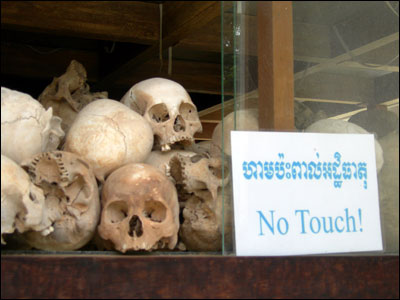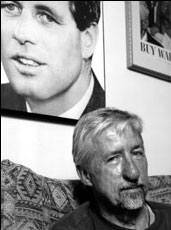
(Perseus Books Group)
This guy ain’t a mother-fuckin MC,
I know everything he’s got to say against me,
I am white, I am a fuckin’ bum, I do live in a trailer with my mom,
My boy future is an Uncle Tom …
And never try and judge me dude
You don’t know what the fuck I’ve been through.
But I know something about you,
You went to Cranbrook, that’s a private school,
Whats the matter dawg you embarrased?
This guys a gangster?
His real name’s Clarance.
And Clarance lives at home with both parents,
And Clarance’s parents have a real good marriage,
… fuck Cranbrook.
Fuck the beat I go accapella,
Fuck a papa doc, fuck a clock, fuck a trailer, fuck everybody,
Fuck y’all if you doubt me,
I’m a piece of fuckin’ white trash I say it proudly,
And fuck this battle I don’t wanna win I’m outtie,
Here tell these people something they don’t know about me
—Eminem
In the climactic scene of Eminem’s biographical epic film 8 Mile, Rabbit, a white rapper, wins a freestyle battle against a rival black rapper. To the racially naïve, the color of the winner’s skin might come as a shock. But as illuminated in this contest, where the winner acknowledges his own whiteness and then reveals that the black rapper attended a private school, skin color alone no longer decides the champions of hip hop’s future. It’s a magnificent moment in the history of hip hop: In this brave new world, class trumps race as an overwhelmingly black audience ushers Rabbit into victory because they identify with him, socio-economically speaking, more so than his black counterpart. This is, of course, part of the mythology Eminem has created for himself, one that has made him the bestselling hip-hop artist of all time and immensely popular with whites and blacks alike.
Class act
In Bakari Kitwana’s new book, Why White Kids Love Hip-Hop, the former executive editor of The Source projects Eminem’s narrative onto all of hip hop’s white listeners: White kids love hip-hop because it addresses their increasing alienation from mainstream society. Citing a host of statistics ranging from growing unemployment rates to the rising cost of higher education, Kitwana argues that an increasing number of white youth are facing the same problems that African Americans have faced for decades: a lack of economic opportunity, deplorable school systems, the inability to earn a living wage. And then he asserts that hip-hop engages these issues more seriously than any other popular art form today.
Unfortunately, this argument loses sight of a few crucial facts. For one, there have always been a substantial number of broke white folk, and not all of them have turned to African American culture to vent their alienation (though many have, as evidenced by the early days of rock n’ roll). There are certainly other cultural outlets for alienated white people that do not involve direct appropriation of black culture. Punk, rockabilly, heavy metal, and grunge, to name a few, have all provided alternative vehicles for poor whites to voice their anger about class-based oppression. How the decline of these genres coincided with the rise of hip hop’s popularity is a fascinating topic, but unfortunately Kitwana does not fully explore the subject in his book.
Kitwana’s analysis of hip-hop as a tool of resistance for young whites also doesn’t fully take into account that poverty does not negate white privilege. Whites, as a racial group, cannot be alienated from mainstream society thanks to the very fact that they, as a racial majority, define mainstream society. While a host of class, gender, sexual, cultural, and personal issues may alienate them (or at least make them feel alienated), their race does not alienate them from the mainstream.
Compounding his book’s troubles, Kitwana asserts that “white youth’s love for hip hop, more often than not, extends beyond music and pop culture to the political arena.” Contrary to what Kitwana would have readers believe, most white kids who love hip hop are not urban, active in leftist politics, and immersed in black culture like Eminem; they are suburban, affluent, politically apathetic, know few, if any, black kids, and have much to benefit from preserving the racial and economic status quo. That is precisely why the idea of the white hip-hop fan is so fascinating: How can hip hop appeal to those who are divorced from the reality it reflects? How can a rich white kid decked out in FuBu, for example, recite every word of 50 Cent’s oeuvre while driving across the Long Island Expressway in a Lexus sport-utility vehicle?
Instead of addressing this inherent contradiction, Kitwana wastes a considerable chunk of time trying to debunk what he sees as the myth that white kids constitute the majority of hip hop’s audience. Whether whites buy more hip-hop music than blacks is irrelevant; majority or not, white audiences are responsible, at least in part, for hip hop’s tremendous explosion over the past decade. This fact, I suspect, is less the result of the politics of alienation than a long history of whites constructing black music as “cool,” dating back at least as far as the first half of the 20th century, when throngs of whites would flock to Harlem to hear all-black jazz ensembles, only to return to the world of white privilege and de facto segregation when the performance was over. Then, as now, affluent white kids construed black culture (and black people, for that matter) as dangerous, unruly, and transgressive, and observed and emulated black culture as an act of teenage rebellion. Today, however, whites are increasingly able to filter their exposure to black culture through music videos and other media, which both renders unnecessary any direct interaction between people of different races and promotes the skewed version of the culture that appears on television. In this way, white kids who grow up in a segregated environment think “acting black” means drinking 40s, packing a gun, and acting like a pimp or gangster, just like 50 Cent, Game, and Snoop (among others) do every night on MTV. Of course, such imitation is not the sincerest form of flattery and reinforces age-old stereotypes and prejudices.
In with the old, out with the new?
While Kitwana fails in his assessment of white alienation, he succeeds in asking some provocative questions about the future of hip hop: Will hip hop, like rock n’ roll before it, be completely divorced from its black roots, abandoned by blacks as the popular cultural vehicle, and reappropriated by mainstream white America? As absurd as an all-white future for hip hop may seem, one need only listen to Gwen Stefani’s recent hit “Hollaback Girl” to get a glimpse of what a predominantly white hip-hop future would sound like. One of last summer’s biggest hits, the song got equal airplay in black and white markets and was produced by the Neptunes, the ubiquitous behind-the-scenes duo whose work has defined the sound of Top 40-hip hop for years.
Though partially nonsensical, the song’s lyrics draw heavily on hip hop’s language and attitude, including the use of clever word plays to disrespect rivals — a device that hip hop inherited from the longstanding African American verbal tradition of “playing the dozens,” or taunting an opponent with a series of increasingly insulting (and humorous) accusations in front of an audience. In this case, Stefani’s unnamed opponent is grunge icon Courtney Love, who publicly denounced Stefani as the music industry’s “cheerleader.” Stefani sets the record straight, challenging Love to an after-school fight, during which she is “gonna make you fall, gonna sock it to you,” until “that’s right, I’m the last one standing, another one bites the dust.” It’s an old school hip-hop battle between two former alternative rock queens and, perhaps, a foreshadowing of the future of pop music.
To complicate matters, Stefani’s song illuminates the difference between what Kitwana terms “old racial politics” and “new racial politics.” According to Kitwana, the old racial politics is “characterized by adherence to stark differences — cultural, personal, and political — between black and white,” while the new racial politics is “marked by nuance, complexity … and a sort of fluidity between cultures.” By extension, Stefani, in the terms of the old racial politics, is a white person trying to be a Japanese person trying to be a black person. But according to the new racial politics, there are no fixed rules and everything is fair game.
While mainstream hip-hop, as seen nightly on BET and MTV generally reinforces the stereotypes of black men as armed, dangerous, and oversexed — and black women as dumb, materialistic, and promiscuous — Kitwana offers another possibility: hip hop as a tool for social change. Calling for a hip-hop underground movement, Kitwana advocates the political mobilization of hip hop’s listeners and creators “to correct social ills that are negatively affecting all Americans, including young whites.” These “hip-hop activists” abide by Kitwana’s new racial politics, with “the vision and capacity to leave the old racial politics on the pages of history where it belongs.”
Kitwana goes as far as declaring that “Em[inem] represents the new racial politics,” though he admits that “in a society where the caste system of whiteness often prevails and bestows privilege, he’s a part of the oppressor class.” What’s so new about that? Even Kitwana’s subtitle, “Wankstas, Wiggers, Wannabes, and the New Reality of Race in America”, reinforces the old racial politics by evoking racist stereotypes. (“Wigger” is a particularly egregious offense. To the best of my knowledge, no one has ever been called a “Whafrican American”.)
A world where a white musician appropriates an African American art form, adds his own white twist, and makes millions of dollars while many of the art form’s pioneers die broke sounds suspiciously familiar. Today’s incarnation of Elvis is Eminem. That is not to say that Elvis and Eminem are not true artists who transcend race. But in the making of these powerful cultural icons, we must acknowledge what was lost, and from whom, in the process. If Eminem represents the new racial politics, as Kitwana claims, I’m not sure I want to say goodbye to the old.
After all, genuine progress in the racial arena will only materialize when we recognize the history of injustice against racial minorities in this country and vow never to repeat it.
Hope for hip hop
An even more pressing question remains: Is a new racial politics possible in a world steeped in old racialisms? While it’s true, as Kitwana aptly points out, that the hip-hop generation is the first to grow up entirely in a post-civil rights era, with youth from all races “socialized around the dream of an inclusive America”, inclusion remains elusive. Racial inequalities proliferate in virtually every field of American life, from de facto segregation in public education to the racist response to and media coverage of Hurricane Katrina.
Quite simply, given the large role played by racism and racial identity in contemporary American society, it’s difficult — almost impossible — to conceptualize a new, large-scale rainbow coalition whose members, like Eminem’s 8 Mile audience, rally around issues of class, rather than race. It’s even more inconceivable that hip hop, with its racist archetypes, will be the driving force behind this revolution. But still, Kitwana’s ultimate assertion that “against all odds we must organize across race” remains compelling, even though his claim that “hip hop is the last hope for this generation and arguable the last hope for America” is exaggerated.
Amidst the larger question that Kitwana raises about the reality of race in America, his reduction of hip hop to a mere tool for political change precludes him from exploring hip hop as an art form. As a result, he overlooks the elements of hip hop that transcend race and class — namely addictive rhythms, clever word plays, and life-affirming beats. In other words, the main reason why white kids and black kids (and everyone else in between) love hip-hop: Like its predecessor, roll n’ roll, it’s got a good beat and you can dance to it.
Michelle L Caswell
Dear Reader,
In The Fray is a nonprofit staffed by volunteers. If you liked this piece, could you
please donate $10? If you want to help, you can also:





 A conversation with Tom Hayden on being stirred by bullies and killers.
A conversation with Tom Hayden on being stirred by bullies and killers. 




